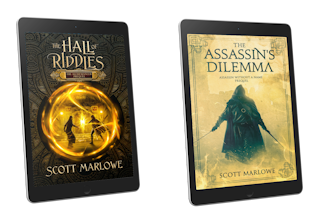
A book, whether electronic or not, is traditionally divided into three parts:
- Front Matter
- Body Matter
- Back Matter
Front matter typically includes but is not limited to the title page, foreword, an acknowledgments section, dedication, table of contents, and a prologue. Body matter is the content itself. Back matter, like front matter, can vary, but might include a glossary, bibliography, index, or an about the author page.
Of course, the structure of a book depends largely on its type. A history textbook is going to be quite different from a fictional novel which is going to be different from a picture book and so on.
I grabbed a couple of print books off the "to read" shelf here in my study to see how the publisher chose to organize their structure. One of the books is Stephen F. Hickman's The Lemurian Stone (which I read a long time ago but want to re-read because it's been so long I hardly remember it) and Stephen King's It (which I've never read).
The following is an amalgamated list of the two:
- Cover
- Excerpt/Praise
- Other Works/Also By
- Title Page
- Copyright Page
- Acknowledgements
- Dedication
- Maps
- Table of Contents
- Content
- About the Author
That's a pretty traditional list. Really no surprises.
It's no surprise either when you bring up an eBook on your eReader and find much the same structure. Most eBooks follow the above conventions because that's the traditional way.
But, of course, times have changed and so too should a book's structure. Or at least an eBook's structure.
I'm not suggesting anything drastic. Just because something has been done a certain way for a long time doesn't make it wrong or ripe for drastic change. In fact, I think altering the structure of an eBook from what people are used to might just generate confusion and put off an otherwise interested reader.
Here is the structure I've settled on for my own eBooks with some comments on each part. The biggest change I've embraced is including various links to my online presence and a shout-out to readers (item 10).
1. Cover
Exactly what you might expect.
2. Copyright Page
The usual legal mumbo-jumbo, but also a link to this web site.
3. Table of Contents
This is more than just a chapter-by-chapter breakdown. The table of contents in an eBook should include links to any section the reader might want to easily access. The TOC of my eBooks includes everything from item 4 down to the end.
4. Other Works
This is a complete list of not only my novels but also some short stories which I encourage any one to read for free.
5. Informational (link to World of Uhl site)
The World of Uhl is where I showcase and, quite frankly, personally keep track of many of the aspects of the world in which I set my novels. It's a work-in-progress in the sense that it's constantly growing as I come up with new characters, places, bits and pieces of Uhl's history, and other pieces of information. I include a link on this page to the site in case it's something readers might be interested in.
6. Informational (Maps)
Fantasy books should have maps. I'm currently rolling out the maps for both of my novels and will be doing the reveal for the map to go along with The Hall of the Wood in a couple of days.
7. Informational (Players)
This is a list of all the characters featured in the novel along with a very brief description of their role. This is reference material meant to assist the reader in keeping track of who's who. You can see all the characters featured in my novels under the People tab of the World of Uhl site.
8. Quote
The Five Elements has one of these. It's an excerpt from The Life of Apollonius of Tyana by the Greek sophist, Philostratus. This obviously should have relevance to the story.
9. Content
The story itself.
10. Request for Reviews
This is a gentle push for readers to return to the retailer where they bought the book in order to leave a review.
11. About the Author
In the end, it's all about me. Just kidding. This is your basic informational page about the author.
Conclusion
There's a lot of innovation going on in eBooks. They're becoming more social, interactive, immersive, and dynamic. I've barely scratched the surface with my own. But considering more and more people are reading eBooks on multi-function tablets with sophisticated graphics and fast internet connectivity, it should be interesting to see what new innovations people come up with for redesigning a format that hasn't changed much in a very long time.
Further Reading

Join my reader's group and get The Hall of Riddles (An Alchemancer Prequel) and The Assassin's Dilemma (An Assassin Without a Name Prequel) as a welcome gift.